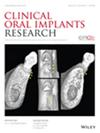在接受抗吸收或放疗的医学受损患者中种植牙:回顾性临床和放射学数据
IF 5.3
1区 医学
Q1 DENTISTRY, ORAL SURGERY & MEDICINE
引用次数: 0
摘要
目的和目的回顾性研究,评估接受抗吸收治疗(AR)或头颈部放疗(IR)的受损患者种植牙的临床和放射学结果。材料和方法对正在接受AR/IR治疗或在接受AR/IR治疗后的受损患者进行评估,并采取具体的预防措施:抗生素预防(手术前2天和手术后5天)和4个月的初级伤口愈合。主要观察指标为观察期间种植体的存活。次要结局包括边缘骨质流失、骨坏死的发生和影响种植体存活的因素。结果共纳入92例患者(IR 59例,AR 32例),种植体369颗。在平均25个月的随访期间(SD: 16), 23个种植体丢失(IR: 21, AR: 2)。IR和AR的种植体存活率分别为92%和98%。确定的种植体失败的危险因素包括在下颌/上颌位置放置、上颌种植、种植体直径4.2 mm、吸烟和糖尿病。IR组的平均边缘骨丢失为0.57 mm (SD: 1.51), AR组的平均边缘骨丢失为- 0.09 mm (SD: 1.17)。结论在严格遵守预防措施的前提下,通过全面的风险评估和对种植指征的仔细评估,种植体可以作为正在接受AR/IR治疗或接受AR/IR治疗后的患者有效的牙科康复选择。与IR治疗后放置的植入物相比,AR治疗后放置的植入物具有更高的存活率和更少的边缘骨质流失。本文章由计算机程序翻译,如有差异,请以英文原文为准。
Dental Implants in Medically Compromised Patients Undergoing or After Receiving Anti‐Resorptive or Radiotherapy: Retrospective Clinical and Radiographic Data
Objective and AimA retrospective study to evaluate the clinical and radiological outcomes of dental implants placed in compromised patients who have undergone antiresorptive therapy (AR) or head and neck radiotherapy (IR).Material and MethodsDental implant placement was evaluated in compromised patients undergoing or after receiving AR/IR therapy following specific preventive measures: antibiotic prophylaxis (2 days before and 5 days after surgery) and primary wound closure with submerged healing for 4 months. The primary outcome was implant survival during the observation period. Secondary outcomes included marginal bone loss, occurrence of osteonecrosis, and factors influencing implant survival.ResultsA total of 92 patients (59 IR, 32 AR) with 369 dental implants were included in the study. During a mean follow‐up period of 25 months (SD: 16), 23 implants were lost (IR: 21, AR: 2). Implant survival rates were 92% and 98% for IR and AR, respectively. Identified risk factors for implant failure included placement in neomandibular/−maxillary sites, maxillary implantation, implant diameter < 4.2 mm, active smoking, and diabetes mellitus. The mean marginal bone loss was 0.57 mm (SD: 1.51) in the IR group and −0.09 mm (SD: 1.17) in the AR group.ConclusionWith comprehensive risk assessment and careful evaluation of implant indications, dental implants can serve as an effective dental rehabilitation option for patients undergoing or after receiving AR/IR therapy, provided strict adherence to preventive measures is maintained. Implants placed following AR therapy demonstrate higher survival rates and reduced marginal bone loss compared to those placed after IR therapy.
求助全文
通过发布文献求助,成功后即可免费获取论文全文。
去求助
来源期刊

Clinical Oral Implants Research
医学-工程:生物医学
CiteScore
7.70
自引率
11.60%
发文量
149
审稿时长
3 months
期刊介绍:
Clinical Oral Implants Research conveys scientific progress in the field of implant dentistry and its related areas to clinicians, teachers and researchers concerned with the application of this information for the benefit of patients in need of oral implants. The journal addresses itself to clinicians, general practitioners, periodontists, oral and maxillofacial surgeons and prosthodontists, as well as to teachers, academicians and scholars involved in the education of professionals and in the scientific promotion of the field of implant dentistry.
 求助内容:
求助内容: 应助结果提醒方式:
应助结果提醒方式:


